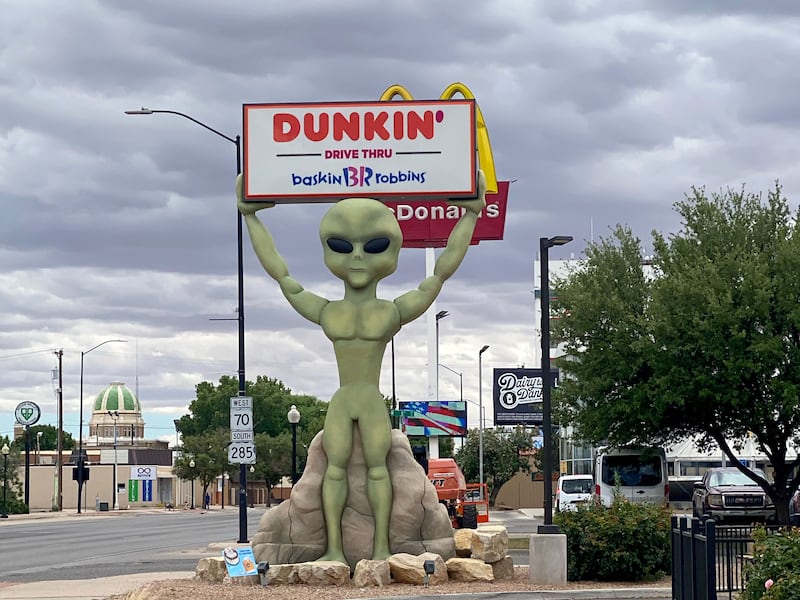The first thing to know about potential alien invaders is that they are no longer classified by the U.S. Government as unidentified flying objects.
That sounds too scary.
They are classified as unidentified aerial phenomena.
It sounds a bit better. Maybe it is just flying junk and debris left in outer space. Aliens have invaded pop culture, but is there more?
Even “Sesame Street” had it down, when a couple of aliens were stranded on Earth.
A newly published study is sparking renewed attention on the connection between unidentified aerial phenomena, er UAPs, and historic U.S. nuclear-testing sites. Researchers found a surprising correlation between mysterious light flashes recorded during 1950s nuclear tests and subsequent UFO reports, raising questions about government secrecy, Cold War-era defense programs, and what the public may have witnessed over decades, have been published, according to a story in USA Today,
Are we alone out here?
These findings have the potential to reshape conversations about both historical defense research and the cultural fascination with UFOs, particularly as public interest in unexplained aerial phenomena continues to grow.
If you’re a UFO enthusiast, you’re probably already familiar with a question that crops up regularly in the slew of never-ending docuseries and congressional testimony: Are otherworldly visitors spying on humanity’s nuclear weapons programs?
USA Today reports some remarkable things
Now, researchers claim they have found tangible evidence that there may be something to that notion. Studying historical photographs from the late 1940s and 1950s, researchers said they were able to spot unidentified flashes in the stars over the northern United States near where nuclear testing was being done.
That could give you shivers on this Halloween night.
The flashes, which the researchers described as “transient star-like objects,” were detected as several mysterious bright spots in the sky.
Utah is not without its own cosmic research
A dozen years ago, the University of Utah teamed up with international researchers in the arena of the study of cosmic rays.
The researchers used hundreds of sophisticated devices in the high, dry desert in Millard County, hoping to learn more about the universe and specifically the formation of cosmic rays.
Cosmic rays are high-energy particles that travel at nearly the speed of light and hit the Earth from all directions, but finding the source of these particles has proven to be elusive.
Those involved in the Telescope Array Cosmic Ray Project say they’re getting closer, however, and they want to expand the project’s size to confirm the location of a “hot spot” that may be the possible origin of the highest energy cosmic rays.
Cosmic rays and aliens
Space is the last frontier, one that few scientists can fully grasp. Was it created by a higher being or did it explode into a vast, unexplainable force?
The National Security Agency Central Security Service reports a litany of “paranormal activity that would astound a visitor to its website.”
If one dares, you only need to go online to see the information compiled so far. There have been dozens upon dozens of movies made about alien invasions.
Utah has done a lot of research in this arena and around the West.
On June 24, 1947, near Washington’s Mount Rainier, private pilot Kenneth Arnold saw nine shiny, saucer-like objects flying in a long chain at 1,200 miles per hour, far faster than any known aircraft of the day. The ensuing media frenzy and many reported sightings in subsequent weeks — including the Roswell Incident in July — kicked off our collective captivation with UFOs.
Pilot Kenneth Arnold’s report on the first UFO sighting in 1947, from which the media coined the term “flying saucers.”
What was once the purview of conspiracy theorists has now entered the mainstream. Advances in sensor technology and personal aircraft use have caused an upswing in reports of what are now called unidentified anomalous phenomena (UAP). The U.S. Department of Defense considers the uptick a potential threat to national security, not from other planets, but from adversarial actors here on Earth.
The University of Utah spoke with Richard Medina and Simon Brewer of the university’s School of Environment, Society & Sustainability about their research that helps make sense of the technology filling our skies. In a study they found that the Western U.S. is the best region to spot UAP due to its dark skies, open spaces and proximity to military installations
Brewer had this to say:
"It boils down to the possibility that other countries, or actors, have technology that is not well understood and potentially poses a threat. The Chinese weather balloon story a couple of years ago illustrated that there could be a range of threats, from surveillance to something more aggressive.
Chinese high-altitude balloon over Billings, Montana, photographed by Chase Doak on Feb. 1, 2023, demonstrate the mystery.
University of Utah’s School of Environment, Society & Sustainability breaks down its research that helps make sense of the technology that maps out the best military installations for observation. This is World UFO Day, keep one eye on the sky.
But as Bill Pullman said in “Independence Day”:
“I will not go quietly into the night.”
So watch your goblins and your ghosts and have a good time and remember Hollywood is just that.
But it makes you wonder.


